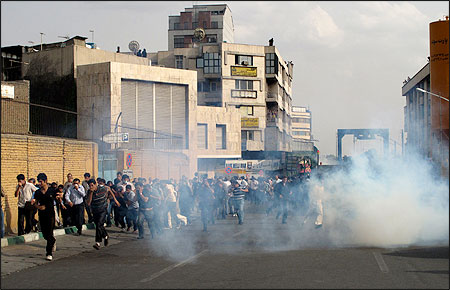
This photograph of unrest in Tehran was published last June on the front page of The New York Times and credited to tehranreporter via Demotix. Photo courtesy of Demotix.
Demotix would not exist in a different time or place. We’re digital, ultra 2.0, collective, collaborative and our purpose derives from forces, economic and otherwise, that are revolutionizing the news media and photojournalism in particular.
We launched in January 2009 with the aim to become The Associated Press (AP) of freelancers—only bigger, quicker, deeper, broader, more local and more global, and a lot more democratic. Our name derives from the Greek words demos (people) and demotic (of the people). Demotix is a place where anybody from anywhere can share their stories with people throughout the world—and with the global mainstream media.
Our idea was simple: to create a virtuous circle providing a refuge for free speech, a safe harbor for correspondents, whomever and wherever they might be, and, in turn, give them access to the eyes, ears and purse strings of news organizations where editors are willing to pay for the stories they have to tell.
As economic pressures bear down on traditional news organizations—and the global reach of their newsgathering capacity diminishes—our network of 3,000 regular contributors (12,000 in all from 173 countries) are on the ground when news happens. It’s the very opposite of “parachute journalism.” Instead of having a correspondent arrive from outside to tell the story, Demotix’s correspondents report from the inside, from home.
‘Street Journalism’
After we launched, people attacked us for cheapening journalism. By enabling anyone to contribute stories, they claimed that we devalued work done by professionals. And they suggested that our newsgathering model—relying on locals to tell local stories—must mean we are abandoning objectivity.
At their core, the arguments against Demotix boiled down to this: By sending their work to Demotix, “street journalists” threatened the status quo and were destroying value in the industry.
Simply put, while the status quo no longer exists, quality still does, and only quality sells. Of our regular contributors, the vast majority are professionals or semi-professionals. We are lucky to have some exceptionally talented amateurs too, but they are only amateurs because they do not support themselves exclusively from their photographic work. We can only license images to the media if they’re as good as the work of the existing wires. More often, the quality has to be better if we’re going to win against the all-you-eat subscription services of Getty, Reuters and AP. We’ve had some extremely successful amateur photography on Demotix—such as the image of Henry Louis “Skip” Gates, Jr., who directs the W.E.B. Du Bois Institute for African and African American Research at Harvard University, taken on the day he was arrested at his own home—but that’s not photojournalism, that’s an eyewitness account.
We describe what we do not as “citizen journalism” but as “street journalism” because the news on Demotix is an expression of the concerns of our contributors, of what they think is news. It’s neither top-down nor bottom-up, it’s flat: equal and collaborative. And collaboration is precisely the piece we feel we add: it’s our selling point. By bringing photojournalists, and (soon) video-journalists and reporters together, we not only help them make money with one-off sales, but we also pull them into a collective photo wire-feed that is expanding its reach to media outlets throughout the world.
There is strength in numbers. Picture editors will license a Demotix photographer’s pictures of the Nairobi riots today because they’ve come to us in the past to license someone else’s feature on the Panjshir Gorge in Afghanistan or a different photographer’s breaking news images from Port-au-Prince, Haiti. Together, we become a global news source—far more than the sum of our parts.
Doing Business
Our model is simple. We split evenly with the photographer the fee we make from a license, whether it’s $1,000 for a Page One photograph in The New York Times or a $20 Web-only fee. We license via File Transfer Protocol to all the major newspapers in the United Kingdom, to a few papers in the United States (The Wall Street Journal and New York Post, for example), and elsewhere.
Each day we send word about our photographs via e-mail to more than 200 news outlets around the world. We maintain digital subscription deals with a host of online-only news sites and we license digital picture galleries from Canada to Bangladesh. We’re building a newsgathering service for NGOs and the mainstream media. Even in our infancy—and despite the dominance of the established news and image oligopoly—hundreds who’ve brought their photographs to our site have made money; some have made thousands, while for others Demotix simply provides a healthy supplement.
We can envision a time when the staff of Web sites, newspapers and broadcasts will include only editors. Until recently, the news industry looked much like the Hollywood studios of the 1930’s where everyone from actors to set designers worked for the company. No more. Twitter is breaking news. Daylife is packaging it. Demotix is sourcing it. Google is parsing it, and countless others will emerge to fill specific jobs. What the people at The New York Times and The Guardian do now is prioritize.
Demotix wants to stay at the coalface, gathering breaking news and shipping it around the world to the packagers (online, broadcast or print) and developing an unparalleled network of local photojournalists and reporters who in telling their stories create a truly global, ultralocal 24/7 digital wire service.
Turi Munthe is CEO of Demotix located online at www.demotix.com. His e-mail address is tm@demotix.com.



